Debunk-Tuesday – The Myth of Overpopulation
Guess who’s back? Back again. Ego’s back, tell a friend. Ahem. Ok, enough of my poor rap skills.
As promised two weeks ago, I’m back with full force (and much more to come). I have plenty of new ideas what to write about starting today with one of the most annoying myths I had to deal with in recent history: the world is overpopulated and will eventually perish because of too many living people. Of course, nothing could be further from the truth.
Facts vs. Fears

Fear is popular. Especially among politicians of every spectrum. The leftists and environmentalists are usually pointing out the many detrimental things, which are bound to happen, if the world’s population keeps increasing. Mother nature will slowly die a painful and horrible death, the peaceful and uncivilised natives of the rain forests will extinguish and in general, everything is going from bad to worse.
Right-wing politicians usually don’t care so much about the environment or indigene cultures, but far more about their own countries. They never get tired of pointing out the dangers of mass-immigration (no, I am not going to discuss this here, since this is a topic for a whole article or even a series of its own) and how problematic it is, that many people from low-income countries with high fertility rates move to a high-income country with low fertility rates. In the understanding of these politicians, people are not going to change at all, when their circumstances change. They will behave as they always have – not matter where they are and what they are dealing with. In addition to that, these people also tend to believe, that fertility rates are always high among some peoples and nothing could ever change that, hence we will have to deal with the consequences of overpopulation at some point. This is even more dramatic, if the highly fertile people move to civilised countries. Eventually, we will all die.
Or will we?
The main problem with these fears is their lack of evidence. I’m not denying that mass-immigration can cause several problems for the host country, if not managed properly. But, yet again, that’s a topic for another article. What I’m referring to is the absence of evidence for overpopulation and high or even increasing fertility rates and that people are not going to change, as soon as their lives are getting better.
Data, not feelings
One of my all-time-favourite websites is Our World in Data. There are arguably very few better sources for data regarding the current state of the world (maybe only matched by the CIA’s World Factbook and the UN’s data.). But surprisingly, even among students of social sciences these websites are rarely known and the very idea of the world getting better seems to be almost heretical. That was at least my observation during my studies, but I would not be surprised, if my biased experienced is very close to the truth.

But let’s start with a definition. In their 2013s article Debunking the Myth of Overpopulation[1] the authors Anne Roback Morse and Steven W. Mosher defined overpopulation as follows:
Overpopulation describes a situation where the number of people exhausts the resources in a closed environment such that it can no longer support that population.
(CC BY-ND 3.0)
Focus on the important aspect: “resources in a closed environment”.
Lands, cities, the earth – they are not closed environments. Not at all. One simple example:
If the earth would be a closed environment, we could not use the sun for energy production or travel to space for a wide variety of research and probabilities of claiming new spaces (pun intended) to live at.
I highly recommend reading the cited article, since it’s a quick, but fun read and presents you the main ideas which I’m writing about in an easy digestible way.
There are, of course, a lot of other aspects to keep in mind, but more about them later.
First of all, we have to ask ourselves, why so many people believe the earth is a closed system with finite resources, which can only be harvested in an exploitable way.
There is mainly one guy to blame for that: Thomas Robert Malthus[2] and the model which occurred based upon his work – the Malthusian growth model[3].
This culminated into the famous equation:
P(t)>P(t) = P0ert</center
with
P0 = P(0) is the initial population size,
r = the population growth rate
t = time.
To make sense out of that, it’s helpful to look at Malthus’ writings. He stated, that each creature’s population has the desire to grow exponential, as long as there are enough resources, hence the growth factor is mainly limited by the availability of resources.
If you read the article by Morse and Mosher I linked earlier, you already know why this is a far too simplistic view when it comes to human societies and their living conditions as well as population growth.
Why am I writing about resources, growth rates and closed environments, when I want to explain you something about overpopulation?
Because it’s important to understand these connections. I already explained, why the earth or its respective cities/lands are not closed systems. So, I will dig deeper into resources (and their availability) as well as current growth rates of human population.
You will see, humans are in fact very different from every other species inhabiting this beautiful blue planet.
Out-resourced
The resources humans currently need are manifold. Therefore, it would be way too much to list them and their availability just in one small pop-sci article. It is for this reason, I’m only concentrating my focus on the most important resources humans need for survival: food and water.
Food for everyone
One of the main arguments of fearmongering politicians and activists is the assumption, there is just not enough food to nourish a bigger human population. This is wrong.
Right now, we are producing enough food to feed 10 billion people(4). The problem is not so much about scarcity of food, but its distribution. Inequality of resource availability along with poverty and bad policies (e.g. corrupt governments in third world countries, wars, etc.) are the key factors when it comes to hunger and starvation. So even if the world’s population is suddenly increasing by another three billion (which is unlikely to happen soon, but more to it later) – we would have enough food to feed them, we just need to figure out how to actually do it.
Currently, a huge chunk of the produced grain crops is used for biofuels and feeding animals. So, it’s a bit questionable (if not outright hypocritical) to complain about the awful situation concerning food in third world countries, while your car runs on that very food. At some day, I will figure out how environmentalists can keep up with this form of cognitive dissonance.
At least, not all hope is lost. I told you earlier, the world is getting better, just many people don’t know about it.
During the last decades, the available food for consumption has increased in most countries(5). On average a man needs 2500 kcal/day and a woman 2000 kcal/day. These amounts vary of course, but it’s helpful to have a general idea about them while speaking about food.
Starting at the 18th century, German citizens, for example, had up to the post-world-war-II-era not much more calories per person available as countries like Ethiopia and Haiti have today.
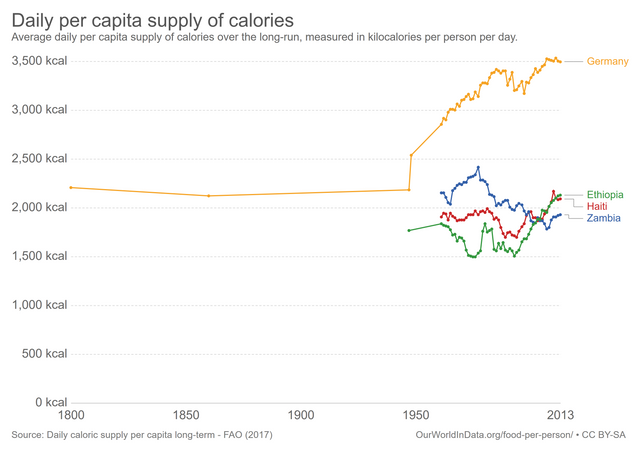
Judging from a global perspective, there is also an obvious trend towards more food for everybody. The disparity between the people on different continents regards the amount of food they have available is constantly decreasing.
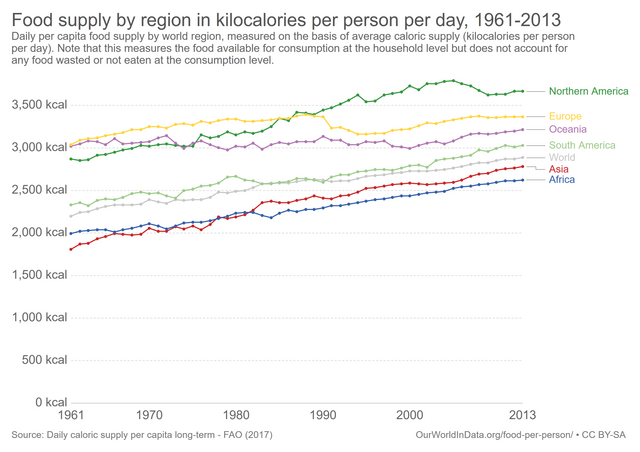
Of course, there are still over 800 million people suffering from hunger worldwide – that’s 800 million too much. But we should not lose the historical and global perspective. In about one or two generations, countries which formerly had relatively low calories per person per day are now among countries with almost no hunger at all. These things take time, but the pace of the current development seems to indicate, people’s living conditions are changing for the better – faster than ever before in human history. This is quite an achievement, we should always keep in mind.
Be water, my friend
When it comes to water, the trend is even more obvious(6). There, we only have to take a look at a 25-years-time-period, ranging from 1990 until 2015. Many different aspects are important regarding the access to clean, drinkable water, but for me, there’s especially one statistic very intriguing: the number of people who have access to an improved water source (like public taps, tube well or protected springs).
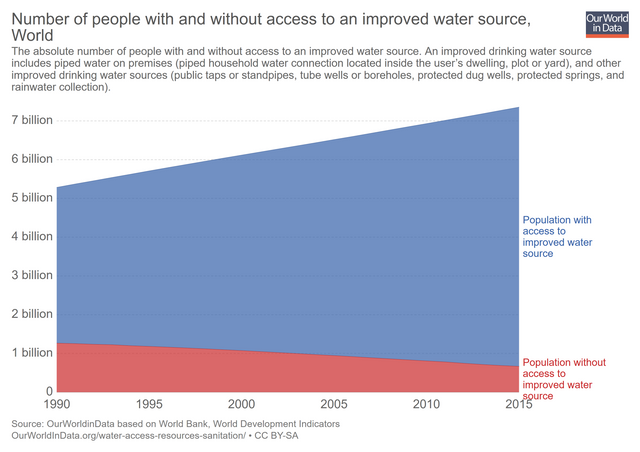
As you can clearly see, in 1990 1.26 billion people had no access to these improved water sources – but over 25 years this number decreased to 665.66 million in 2015 (which is a decrease by almost 50 percent), while at the same time the world’s population increased by another 2.08 billion. So, we had more people to provide water for, but in total the number of people who had no access to improved water sources decreased drastically over a relatively short time period. I am curious, how the numbers will look like in 2040.
Again, I’m quite confident, the world is rather getting better than worse.
Be fertile and multiply
Finally, we are reaching peak excitement. Growth rates(7) and fertility(8). With the last paragraphs I tried to convince you, that there are currently enough resources to host a few billion people more, I will now explain, why the Malthusian Growth Model is not necessarily true when it comes to humans, at least not on a global scale.
Right now, we have more resources at our disposal than ever before in human history and we have the ability to harvest them in even more efficient ways or creating completely new ones. But instead of another population explosion like the one which occurred between 1950 and 1987 – doubling the world’s total population in only 37 years (2.5 billion to 5 billion), the growth rates are declining and the time period increases for each additional billion of humans.
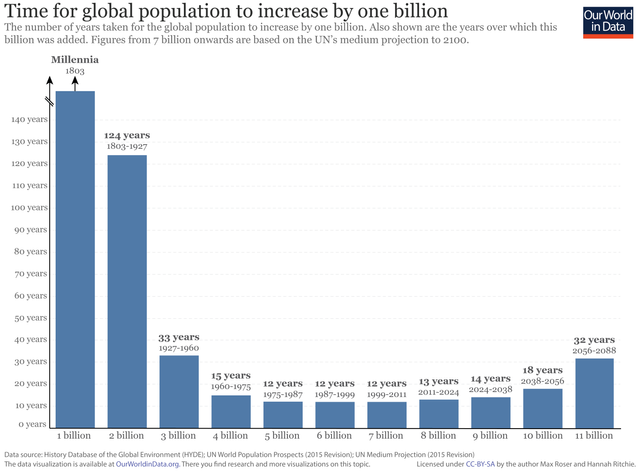
The highest annual growth rate of the human population was decades ago: between 1962 and 1963, peaking at 2.2% per year. Since then, the growth rate is ever decreasing. Some countries like Russia and Japan have even a negative natural growth rate, meaning their citizens having more deaths than births, which will eventually lead to their extinction in a very far future and without taking migration into account.
Some might now argue, that this decline in growth rate is only something which can be seen in developed countries, since we all know, that poorer countries have increased fertility rates in comparison to their richer counterparts. In fact, this argument is indeed quite popular among many people who are critical towards immigration from these poor regions into richer ones.
If only it were true.
The current trends seem to indicate the exact opposite: every region, no matter if developed or not, will experience a continuing decline in growth rate.
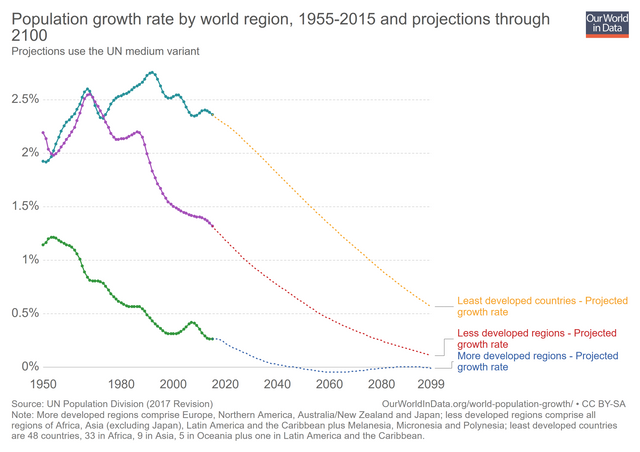
There are many reasons for these trends. Against popular beliefs, the dominant religion of a country or its respective people is among the least crucial factors which are contributing to their fertility and therefore their growth rate.
According to a paper by Timo Wacker this can be summarized as follows(9):
It was shown that the religious affiliation of a family - in contrast to household income, the substitution behaviour with rising income, the mortality rate and other social and societal factors - has only a small influence on the actual fertility of this family. While for the other factors a direct correlation could be proven theoretically and practically, the analysis of religion has shown that on average there is no significant difference between the fertility rates of different religiously influenced countries due to their religion.
Translated with the author’s permission from German to English.
This conclusion holds true as soon as you take a closer look at the available data. There is a lot of fearmongering going on when it comes to immigrants from Islamic countries. A very popular argument is, these immigrants are going to produce as many children as they used to, when they were back in their home countries. Being a hardcore atheist, who happens to have a decent education in economics and psychology I found this always hard to believe. Especially considering the fact, that undeveloped countries with either a Muslim or a Christian majority are currently the ones which have the highest fertility rates. So, it’s not only one specific religion, but at least two.
But, as stated, compared to other factors, religion is relatively insignificant.
To put matters into some perspective, we can cite Max Roserref:
In Catholic Italy the fertility declined from 2.5 in 1966 to 1.2 at its lowest rate in 1997, and in Muslim Iran the fertility declined from 6.5 children per woman in 1982 to 1.8 in 2005!
So, what are the factors, which are most important regarding fertility rates?
As stated by Wacker, some of these factors are mainly household income as well as (child) mortality rate. The latter is quite logical on its own: if parents don’t have to fear that their child will die during its early years, they don’t need to produce so many to ensure to have at least some offspring. While in the 18th century more than 40% of all children died(10) during their first five years, this number has decreased to only 4.25% in 2015. Needless to say, the number of births per woman has also decreased significantly.
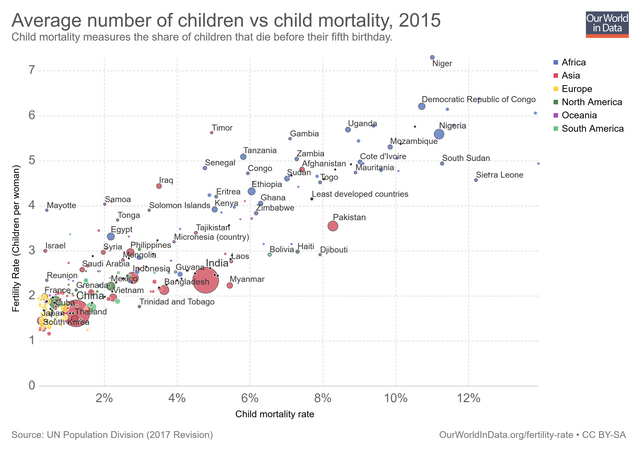
In addition to increased income and decreased child mortality, I want to point out another factor which contributes to fewer children: empowerment of women.
This means in general a better education and healthcare for women, which can then lead to them producing fewer children on average.
As some of you may know: I hate children. I think of them as annoying and pesky, little brats – therefore, I’m a feminist for my own good. The better women are off, the lesser the risk for me having to deal with children.
Some authors are even arguing that education is the most important factor for demographic change of all(11). And the available data seem to support this idea, since in countries where women had initially an education of about zero years, which later changed to something around six years, the fertility rates declined by about 40%. What a bliss.
The world is getting better, not worse
So, here we are. I tried my best to provide you with some convincing evidence, that the current state of the world is by far way better than most people actually believe.
We have enough food and resources to host more people and the growth rate of the human race is declining every year. With more income to spend, better education and healthcare this will most likely only going to increase (although there are some authors who argue otherwise(12)).
Humans are getting older, richer and better educated all around the globe – eventually, the transhumanistic dream will come true at some day and the fact of death will only be a mere choice. That could become interesting.
Speaking of dreams: there is something I haven’t really talked about during my extensive display of different factors, theories and statistics – human ingenuity.
The human race has always used its cleverness to harvest more resources from its environment than any other animal could ever dream of. We invented so many technological advances which ultimately led to us being the dominant species of this planet. One could easily argue, that we actually never lived in peace and harmony with mother nature, because we were always searching for new and different ways of making the most out of our surrounding environment. I’m still waiting for a pyramid-equivalent built by chimps.
So, even if the number of humans inhabiting this planet is increasing, I am very confident, we will find more ways to deal with them properly. Scientific progress has led to better food, better healthcare, cleaner water and so much more for everybody.
It is for this reason, we should always cherish facts and data – not feelings and fears.
Feel always free to discuss my ideas and share your own thoughts about the things I’m writing about. Nobody is omniscient and if we all walk away a bit smarter than before, we’ll have achieved a lot.
Thanks for reading and stay sceptical.
Comment me upvote me if you like this post and share your opinion with me on steemit. Follow me @vuthanhtai
Thank you.